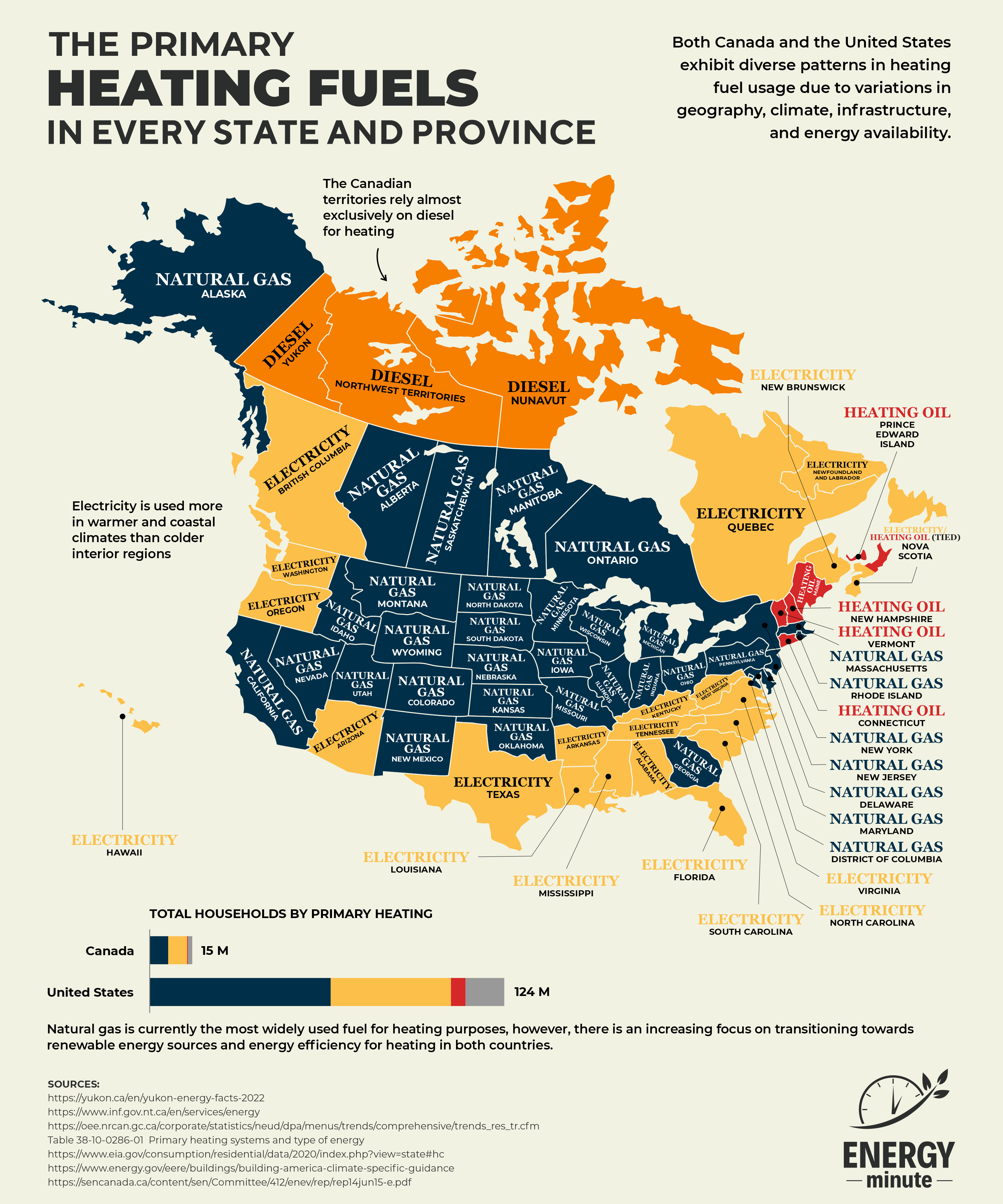Heating Fuels Across Canada and the US

Different fuels used for heating
- Natural gas is one of the most common heating fuels due to its cost-effectiveness and high efficiency. It provides more heat per unit of fuel compared to others and is conveniently supplied through pipelines, eliminating storage needs. However, it’s dependent on infrastructure availability and raises safety concerns due to the risk of leaks. Although cleaner than oil or coal, it’s still a fossil fuel contributing to greenhouse gas emissions.
- Electricity is widely accessible in urban and suburban areas and offers a clean heating solution at the point of use, with no emissions in the home. It powers various heating systems, including heat pumps and baseboard heaters. The drawbacks include potentially high costs and less efficiency in extremely cold weather. The environmental impact of electric heating depends on the source of the electricity, with coal or gas-powered plants being less environmentally friendly.
- Heating oil is a significant source of heat in regions without natural gas infrastructure. It produces a high heat output, making it effective in colder climates. However, it is generally more expensive than gas and electricity and requires on-site storage and regular refueling. It also has environmental concerns, producing more carbon dioxide and pollutants than natural gas.
- Propane offers versatility for heating, cooking, and hot water, and is a good option in rural areas where natural gas isn’t available. It’s cleaner than heating oil but more expensive than natural gas. Propane requires storage tanks and regular deliveries, and like natural gas, it poses a risk of leaks.
- Wood, considered a sustainable and renewable resource, can be a cost-effective heating solution, especially if one has access to wood. It’s particularly useful in remote locations without access to other utilities. The labor involved in cutting, storing, and feeding the wood, along with its inconsistent heat output and the emission of particulates, are its main drawbacks.
Heating fuels across North America
The distribution of different heating fuels across North America is influenced by a variety of factors including regional availability of resources, climate, infrastructure, and economic factors. Here’s a general overview:
- Natural gas: This is the most widely used heating fuel in North America, particularly dominant in the United States where extensive pipeline infrastructure exists. It’s heavily utilized in urban and suburban areas across both the U.S. and Canada, with high prevalence in regions like the Northeastern U.S. and Canadian provinces such as Alberta and Ontario. Natural gas is favored for its cost efficiency and convenience.
- Electricity: Electricity as a heating source is common throughout North America but is particularly prevalent in areas with limited access to natural gas. In the U.S., it’s widely used in the southern states, where heating needs are generally lower. In Canada, provinces like Quebec and Manitoba, which have abundant hydroelectric power, rely heavily on electricity for heating.
- Heating oil: This is more common in the Northeastern United States and Atlantic Canada, where other forms of heating fuel are less accessible or have been historically less integrated. Heating oil usage is less widespread in Canada, limited primarily to more remote areas or where other fuels are not readily available.
- Propane: Used mainly in rural areas not served by natural gas pipelines. In both the U.S. and Canada, propane is a significant heating source in midwestern and northeastern regions, as well as in more isolated communities.
- Wood: Wood heating is most common in more rural, forested areas of North America. It’s particularly prevalent in the northern parts of the U.S. and Canada, where wood is abundant and other heating options might be less accessible or more expensive.
Each region’s preference for a particular heating fuel is shaped by historical, geographical, and economic factors. For example, regions with abundant natural resources like natural gas or hydroelectric power are more likely to use these resources for heating. Similarly, colder regions tend to have a broader mix of heating fuels, reflecting a greater need for reliable and efficient heating solutions.
There’s also a growing interest in renewable and environmentally friendly heating options across North America, such as solar or geothermal heating, although these are currently less common compared to traditional fuels. The distribution and usage patterns of heating fuels are expected to continue evolving, influenced by factors like technological advancements, changes in energy prices, environmental concerns, and governmental policies.
Sources
https://yukon.ca/en/yukon-energy-facts-2022
https://www.inf.gov.nt.ca/en/services/energy
https://oee.nrcan.gc.ca/corporate/statistics/neud/dpa/menus/trends/comprehensive/trends_res_tr.cfm
https://www150.statcan.gc.ca/t1/tbl1/en/tv.action?pid=3810028601
https://www.eia.gov/consumption/residential/data/2020/index.php?view=state#hc
https://www.energy.gov/eere/buildings/building-america-climate-specific-guidance
https://sencanada.ca/content/sen/Committee/412/enev/rep/rep14jun15-e.pdf




